

| Don Denny describes the "remarkable image of Hell, which fills the right half of the bottom register and the right part of the middle register. Some sixty figure are represented; the damned are beaten with clubs or forks, knocked down, bitten, pulled by the beard, hanged by the neck or ankles, roasted over the fire, caught in nets, etc. There is a pervasive quality of realism to the bizarre tortures. No early twelfth-century representation of Hell--nor any of a yet earlier time--is so populous and so filled with varied circumstantial detail" (8). | ||
A jumble of figures and bizarre torturesDetail in the middle of the row below: Monks are caught in the devil's net and one even prostrates himself before a pot-bellied demon--his crozier, the hook of which is visible on the ground, identifies him as a monastic superior. In the center of that image, a heretic holding a book has fallen on his back; one demon stand on him while the one below stabs him in the back and appears to be eating his head. At the far right a demon holds a container and forces the seated figure to drink. This seated figure has been identified as a false money changer; the flames on the ground indicate he has been melting metal to make counterfeit money; he will now have to drink this molten liquid. | ||

|
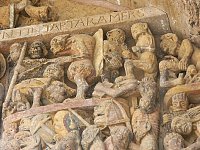
|
The middle register, right half |
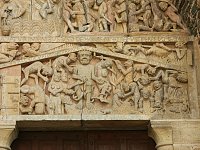
|
The bottom register, right sideThis panel on the right provides an obvious contrast with the panel on the left. There, Abraham was enthroned and was flanked by orderly rows of the saintly. (See preceding page.) Here, Lucifer presides, and the chaos that is Hell is evident. Although he is centered and larger, he is surrounded by sinful beings being tortured. Under his feet a man is lying on a brazier. This figure is sometimes described as a representative of laziness or sloth. On Lucifer's left a figure is hanging with a bag of money around his neck. Sometimes identified as Judas, he may represent the more general sin of greed. To Lucifer's right a male and female figure are roped together at the neck. Since they are in Hell, we might assume the liaison was illegitimate (he looks like a monk) so this couple represents lust. At the far left of this scene a man in chain mail has been taken from his horse by two demons and is head down, perhaps about to be robbed of his valuable armor. This figure is sometimes seen as an example of pride, the worst of the seven deadly sins from which all others flow. | |
Center: Lucifer with Greed to his left, Lust to his right, and Sloth as his feet; Right: Pride and a closer view of Lust |
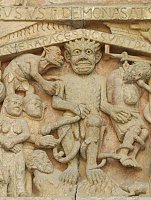
|
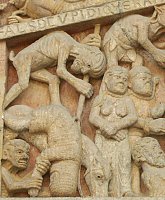
|
| Not all the sins represented in this frightening image of Hell and its tortures are contained within the medieval pattern of the Seven Deadly Sins. (Gluttony and Anger are represented in parts of the tympanum that are not illustrated here in details.) Below, a seated man, engulfed by flames has his tongue removed by a demon--a figure often interpreted as a personification of slander or gossip. Next to him there are two human figures--a man with a woman sitting on his shoulders; this is probably a shrew who has not been tamed--not a particularly shocking image, given medieval misogyny. | ||
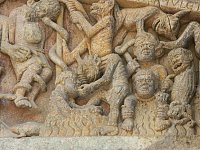
|
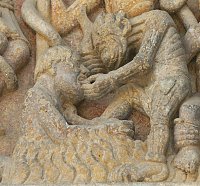
|
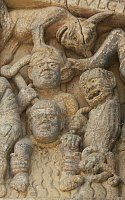
|
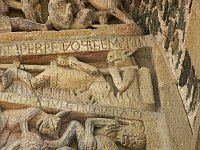
|
The poacher?"The right-hand triangle portrays an astonishing and ironical scene: two demons are roasting a man on a spit above the flames, one of whom has the head of a hare. Should we interpret this as the torture awaiting the poacher? Or quite simply that in Hell, this inverted world, the hunter has become the victim of his prey" (Delmas and Fau 40). Had Hieronymus Bosch seen this tympanum? | |
| The official guide to the tympanum identifies the figure in the center image below as a dishonest caterer, with a huge belly, who is being tortured by being thrust into kitchen equipment. Several images in Hell relate to the pleasure and sins of eating and drinking--Gluttony. | ||
| Right: Delmas and Fau identify the figure to the left as Anger, one of the Seven Deadly Sins. They view him as a suicide--he thrusts a dagger into his neck; it make more sense to me to see him as Despair--the most unforgivable sin of all. Next to him a Demon has taken the harp of a musician (who played at orgies?) and rips out his tongue with a meat hook. | 
|
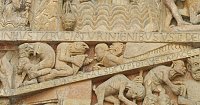
|
 Go to Sainte Foy Index.
Go to Sainte Foy Index.
 Click here to return to index of art historical sites.
Click here to return to index of art historical sites.
 Click here to return to index of artists and architects.
Click here to return to index of artists and architects.
 Click here to return to chronological index.
Click here to return to chronological index.
 Click here to see the home page of Bluffton University.
Click here to see the home page of Bluffton University.

